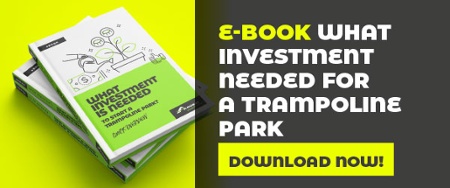Trampoline parks are one of the fastest-growing activities in the entertainment industry. Therefore it is not surprising that a lot of people see them as business opportunities. Since the start-up and operating costs for trampoline parks are a considerable financial investment, before opening a trampoline park you should get a clear financial picture and think about the many key factors that influence how successful the launch of your trampoline park will be. But the challenges don’t end there. If you want your trampoline park to be successful in the long run, you have to plan your monthly operating costs while you are still in the planning phase.
Planning is the key to success
If you worked up a good financial plan before starting construction of the trampoline park itself, then you undoubtedly did not forget about operating costs.
Operating costs are an important element that has to be taken into account when planning your trampoline park.
Below we present the costs that you will have to think about in order to keep your trampoline park running every month. One of the first things that should be mentioned is that the level of costs depends most of all on:
- your location,
- your requirements and
- your wishes regarding the look and quality of the equipment and installation.
And you shouldn't forget about insurance and financing.
1. Leasing
Leasing or rent is the sum, for which you will have to allocate a certain part of your funds in the event that you are not the owner of the facility that houses your trampoline park.
2. Additional spaces
Here, we are talking about additional spaces within the trampoline park, such as a pub or restaurant. While it is true that you will have with them a lot of revenues, but on the other side you have to think about employee salaries and all other costs associated with keeping food service establishments up and running.
3. Maintenance of equipment
Equipment at the trampoline park needs to be inspected regularly for safe use. It is also very important for equipment to get repaired as soon as possible in the event of damage.
4. Marketing and promotion
Marketing and promotion plays the important role into making your trampoline park attractive and well-known to the largest possible number of people. Therefore you will have to allocate additional funds for promotion, organisation of special events and promotions via various marketing channels.
5. Labour costs
Labour costs stands for the employee salaries. The plans for the indoor trampoline park are usually a good basis for determining how many employees you will need to keep the park running smoothly. The number of employees depends on the size of the trampoline park, and you also have to pay attention to any special skills that employees have for doing certain kinds of work.
6. Equipment costs
Equipment costs are important in times when you have to renovate the trampoline park or simply add attractive new elements. You have to be aware that when building an indoor trampoline park nothing is ever completely finished, as you have to continuously upgrade and add new elements.
7. Insurance costs
Insurance costs cover any injuries, which are covered under the sum insured. In all cases where the exposure to such risks is high, insurance costs can be a significant operating cost.
8. Financing costs
Financing costs usually relate to interest on loans and all other costs associated with obtaining the loans. Before making the investment, you have to think hard about the method you will use to finance the entire project, or put more simply, where and how can we obtain funding so that our investment is economically sustainable. There are quite a few options, from bank loans to finance leases.
Planning a trampoline park is a complex project, which doesn’t end with its construction and successful launch, but also requires thinking about all of the monthly costs that arise during the operation and maintenance of the park. The park’s equipment plan and financial plan are two key factors that can significantly help you plan your investment and manage your current operating costs.

